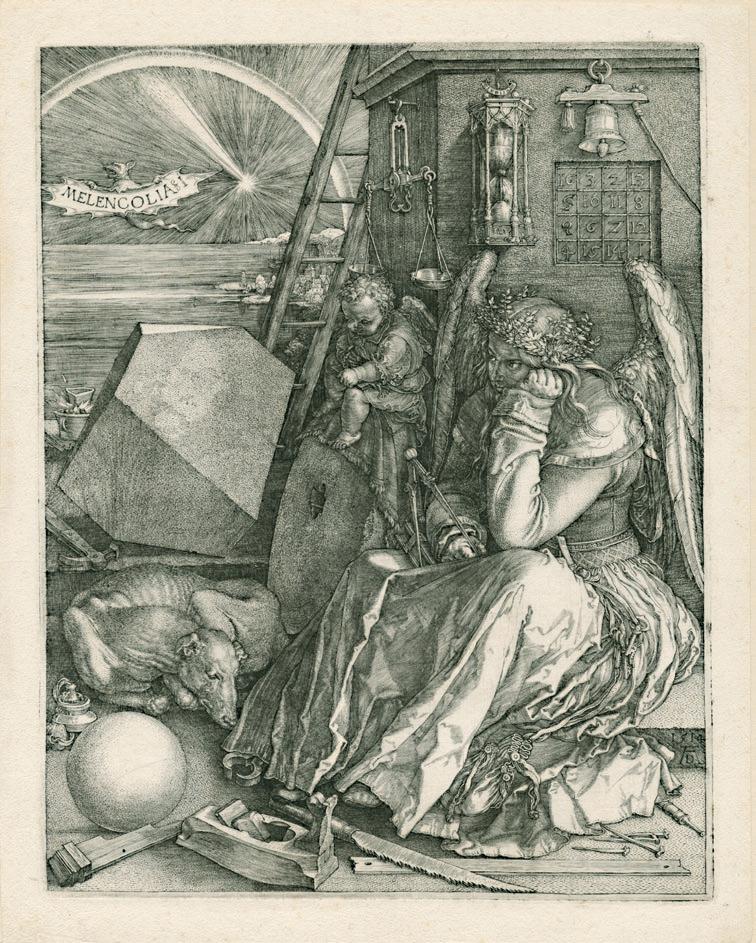
38 minute read
Fascinated with the Other
Imagination and Psychiatry
Imagination and psychiatry are closely linked. The first psychiatrists drew or painted portraits of their patients to illustrate specific syndromes. It is no surprise then that photography and psychiatry arose at about the same time. Photography was regarded as a useful tool in the observation of patients: their behaviour, facial expressions and uncontrolled movements appealed to the imagination and were recorded as accurately as possible. However, patients themselves also created pictures and drawings. When doctors began to pay attention to the visual creations that arose within the walls of the hospital, it was the start of what is now called outsider art. The term is drawn from the publication of the same name written by Roger Cardinal in 1972. It means more than just art made by psychiatric patients. Cardinal used the word as a synonym for art brut (raw or rough art), a concept coined by Jean Dubuffet in 1945. Dubuffet also looked beyond the hos pital walls for ‘authentic’ art, which, for him, was separate from ‘cultural’ art.
The term outsider art now covers an endless spectrum of subcategories and has even become a brand. Paradoxically, the attention that Dubuffet and Cardinal drew to outsider art has isolated it from ‘professional’ art. For a long time now, many arguments have been made to abandon outsider art as a separate category. It is a fierce debate which already has an interesting history in curation. Outsider and professional art have been presented together in exhibitions for a long time, but the distinction is still often tangible. Why is it so difficult? Why do people keep looking for art that, in their opinion, differs from the norm? The answer can be found in people’s fascination.
Albrecht Dürer, Melencolia I, undated, engraving.
Nauta Collection, Rotterdam
Homo melancholicus—the vulnerable genius— was immortalised in an iconic way in 1514 by Albrecht Dürer (1471–1528). The composition is dominated by an androgynous figure with wings in the typical melancholic pose. She is wearing a garland of water plants to avoid dehydration, because her nature is cold and dry. Attached to her belt are keys and a purse, references to Saturn, the god of the earth. The unused tools on the ground also refer to him. Dürer depicts the modern artist in Melencolia I, who is not only a craftsman but someone who undertakes intellectual work. Theory and physical rest are both parts of artistic practice.
MADNESS
Fascination for what? Humankind has always been fascinated by that which is different, that which transcends reason, and madness has been an object of fascination since ancient times. A wellknown example is the double nature of melancholy. For example, the opening line of Problemata XXX.1, attributed to Aristotle, reads: ‘Why is it that all those who have become eminent in philosophy or politics or poetry or the arts are clearly of a melancholy temperament, and some of them to such an extent as to be affected by diseases caused by black bile?’ The apex of this fascination was during the romantic movement, when artists set aside reason to work from emotion. The irrational was central to this. Mad people were regarded as primitives who were not inhibited by reason or by what was regarded as morally correct. The romantics saw madness as the liberation of instinct. This fascination and curiosity led artists to asylums, where they observed not only the inmates but the art created by them.
PATIENT PORTRAITS
Even before the emergence of psychiatry at the end of the eighteenth century, mad people were being drawn and painted. Sander L. Gilman examines the way in which mentally ill people have been depicted from the Middle Ages to the nineteenth century in Seeing the Insane. A Visual and Cultural History of Our Attitudes Toward the Mentally Ill (1982). In the Middle Ages and the Renaissance, the ‘otherness’ of the insane was indicated by giving a melancholic person a darker skin, or by depicting specific postures, gestures and movements. Treatment methods were also illustrated, like exorcism, music therapy and ‘cutting the stone’. In some cases, the mentally ill were depicted in a group, as in the Ship of Fools by Hieronymus Bosch, but in all cases we see ‘the’ mad person: a stereotype without any individuality. Artists maintained the conventional visual language.
One of the most famous depictions of the insane in the eighteenth century is the last of the eight engravings of A Rake’s Progress made in 1735 by William Hogarth (1697–1764). The series illustrates the eight stages of the ruin of Tom Rakewell, a young man who leads a loose and immoral life. He ends up in Bethlem Hospital, then better known by its nickname, Bedlam. Rakewell is depicted in the foreground, surrounded by eight insane men. The engraving shows that Hogarth was aware of the most important


Anonymous, The Rake’s Progress: in Bedlam, after William Hogarth, c.1850, engraving.
Dr. Guislain Museum, Ghent
psychiatric symptoms of his time. He depicts Tom’s fellow inmates in a characteristic way, with identifiable diagnoses. Although he employs a recognisable visual language, he also tells a personal story. We also see a patient drawing on the wall. In so doing, William Hogarth is, according to John M. MacGregor, author of The Discovery of the Art of the Insane (1989), one of the first artists to depict the artistic work of a psychiatric patient. He asserts that the investigation of the art of the insane began here and in similar Bedlam scenes.
The engraving is also important for another reason, however. Two ladies clearly do not belong among the insane: they are voyeurs. Bethlem Hospital allowed people to visit for a fee and considered itself one of the top places of interest in London — an early tourist attraction, if you will. Curiosity for the other, the sick and the mad could easily be satisfied, as long as you could pay for it.
Doctors also made portraits of their patients, or had them made. The first medical illustrations of mad people can be found, according to Gilman, in the Traité médico-philosophique sur l’aliénation mentale ou la manie (1801) by Philippe Pinel (1745–1826), where the French doctor combined physiognomy with a case study, just as, 20 years later, his student JeanEtienne Dominique Esquirol (1772–1840) created portraits of specific cases, individuals, and not just stereotypical depictions of categories of illness. Portraits of patients can also be seen in Leçons orales sur les phrénopathies (1852) by Joseph Guislain. In the same period, EtienneJean Georget (1795–1828) asked his friend Théodore Géricault (1791–1824) to paint ten of his patients. Both men died before the project was completed and the pictures were never published, but five were preserved, including Portrait of a Kleptomaniac (c. 1820).
The interest in portraits of individuals reflects the development of psychiatry and the ethical approach towards the end of the eighteenth century. The idea that mental illness could be cured meant that sick people were given a place in society again, albeit within the walls of a hospital. The asylum was also abandoned by artists in the nineteenth century in their depictions of the mentally ill, but there was always a clear reference to confinement.
Photography began to be adopted by psychiatry in the mid nineteenth century. It was assumed that a photo was always an objective representation of reality. JeanMartin Charcot (1825–1893),

Mélancholie (Melancholy) and Extase (Ecstasy), from: Joseph Guislain, Leçons orales sur les phrénopathies, 1852, Ghent.
Dr. Guislain Museum, Ghent

a doctor specialising in hysteria at the Hôpital de la Salpêtrière in Paris, was at the birth of the bestknown photographic publication in the realm of psychiatry: Iconographie photographique de la Salpêtrière, which appeared between 1877 and 1880 and illustrated Charcot’s findings in hysteria. Albert Londe (1858–1917) played a large role in the resumption of the journal in 1888 as the Nouvelle Iconographie de la Salpêtrière. He expanded the photographic service of the hospital, paying close attention to chronophotography, which allowed movement to be captured. The photos, including that of Augustine, the ‘star’ of hysteria, had a very theatrical quality and became iconic.
Charcot gave a lecture twice a week. He presented cases of hysteria in an amphitheatre that could accommodate 400 spectators. It is apparent from the descriptions of the participants, from which Frans Gilson distilled the atmosphere in Tijdschrift voor Psychiatrie (Journal of Psychiatry) (2010), that the audience did not consist exclusively of medical practitioners: ‘The hall was filled to the rafters with a diverse audience drawn from all over Paris: writers, famous actors and actresses, the fashionable demi and beau monde, all morbidly curious. Just as in a theatre, you enter from the back of the hall and you walk down to join the row at the front. The dark red walls are also reminiscent of a theatre.’ Gilson talks of the ‘Circus Charcot’, in which young women under hypnosis on the stage were lit by a spotlight while they went through the various stages of a hysterical fit.
The lectures attracted spectators from abroad as well as from Paris. The link with the paying visitors in Bethlem is obvious, but what was different about the spectators for Charcot’s ‘Tuesday lessons’ was that many of them didn’t just come for entertainment, but for inspiration. One of the spectators was Sarah Bernhardt (1844–1923), whose performances were inspired by the hysterical movements she saw at Charcot’s lectures. Sigmund Freud was, in his own words, ‘enthralled’ when he saw her in the play Théodora by Victorien Sardou in 1885. Bernhardt was a star who had studied that other star, Augustine, very carefully. Augustine was often photographed and presented, not just because of how she looked, but also because her symptoms presented themselves in clear and definite acts. She was quickly christened the ‘Sarah Bernhardt of the Salpêtrière’ and she still appeals to the imagination even now. She was the subject of the film Charming Augustine (2005) by
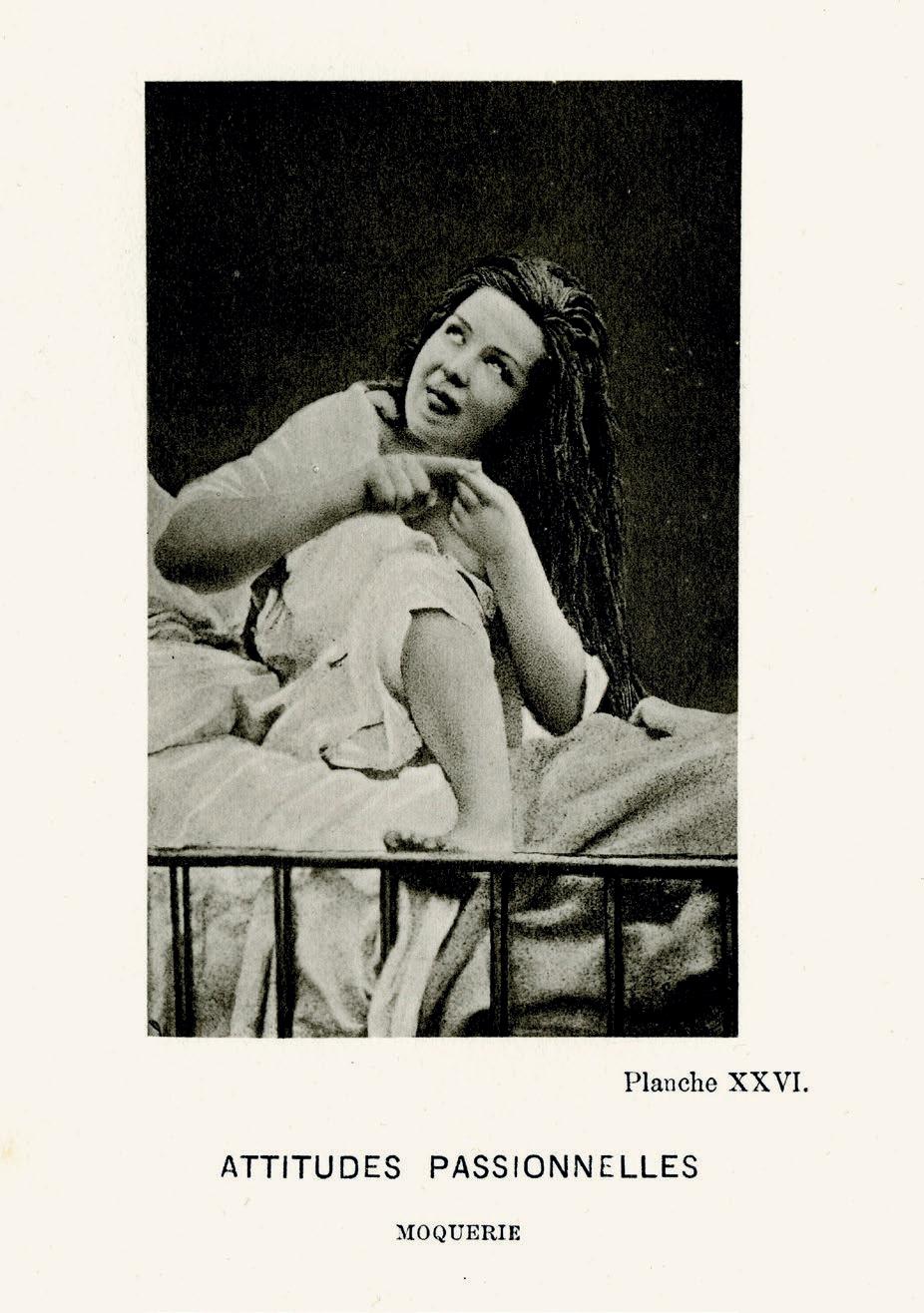
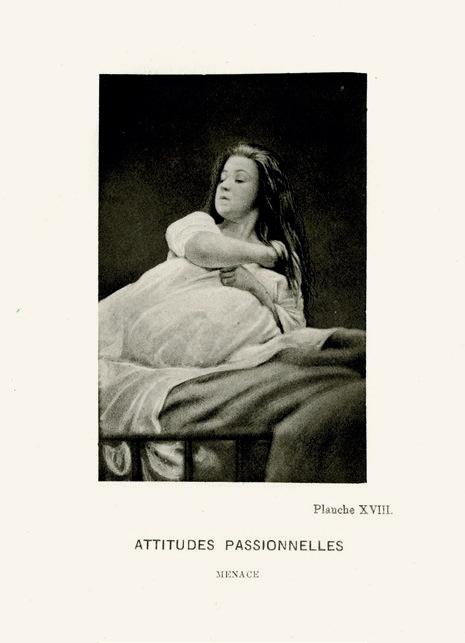

Paul Regnard, Attitudes passionnelles (Passionate postures), photographs of Augustine Gleizes, from: Iconographie photographique de la Salpêtrière, volume 2,
1877–1878, Paris. Dr. Guislain Museum, Ghent
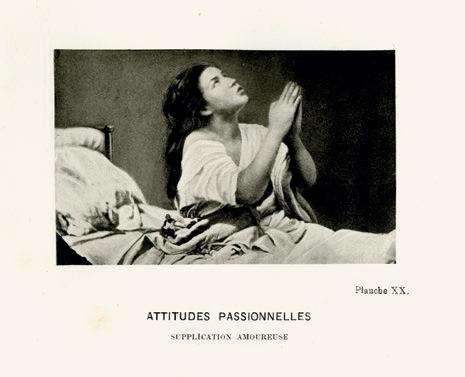

(p.121) Paul Regnard, Léthargie (Lethargy) and Catalepsie (Catalepsy), photographs of Augustine Gleizes, from: Iconographie photographique de la Salpêtrière, volume 3,
1879–1880, Paris. Dr. Guislain Museum, Ghent



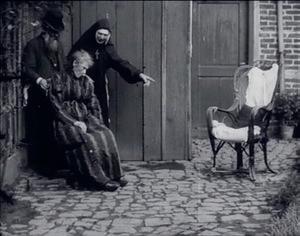
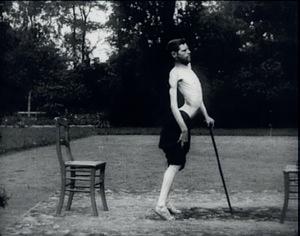

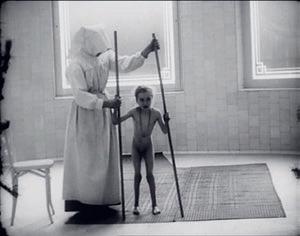







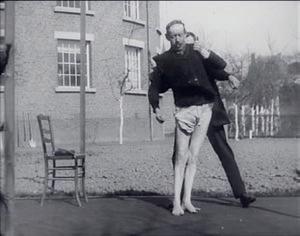

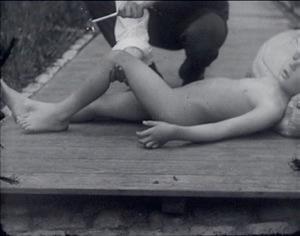
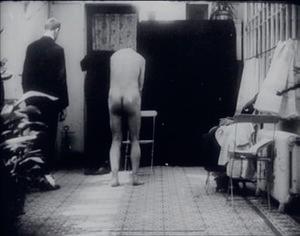
American artist Zoe Beloff, and she has also been portrayed in plays and books.
Sarah Bernhardt was not the only person who sought inspiration within the walls of a psychiatric institute, however. According to literature professor Rae Beth Gordon, other practitioners of the performing arts looked to the jolting and uncontrolled movements of the patients of La Salpêtrière to add spice to their work. An entirely new genre of performing artist arose in France in the 1870s and 1880s: la chanteuse épileptique, le chanteur agité, le comique idiot, etc. The tics and strange ways of walking found their origin with doctors such as Edouard Brissaud and Georges Gilles de la Tourette, who researched problems with walking caused by neurological disorders. Actors like Charlie Chaplin became famous with their characteristic way of moving.
Besides drawings and photos, film was also used to observe patients. Belgian neurologist Arthur Van Gehuchten (1861–1914) began filming his patients systematically at the start of the twentieth century. He made short films of one to two minutes which he used to illustrate his lessons and lectures. Van Gehuchten was a world authority in neuroanatomy and was the first professor of neurology at a Belgian university. According to researcher Geneviève Aubert, his films demonstrate a diverse range of cinematography. He used various camera angles, closeups to capture certain reflex reactions and long shots to demonstrate patients’ postures and ways of walking. Choreographer Alain Patel of the dance company les ballets C de la B had his dancers watch Van Gehuchten’s films for the production vsprs (2006). He was looking for the tension between the subconscious and the superconscious, between uncontrolled movement and the classical rules of choreography. Platel also focused on the body language of the subconscious, spasms, convulsions and ticks for Out of Context – for Pina (2010). The spectrum of movement varied from blinking or frowning, jerking limbs and movements to falling over or a silly walk.
PATIENTS’ VISUAL ART
What is now called outsider art has its roots in psychiatry. John M. MacGregor argues that, although the art world was responsible for the discovery of outsider art as art, it was doctors who first showed interest in it. They began to collect, classify and study the work of their patients systematically at the end of the nineteenth
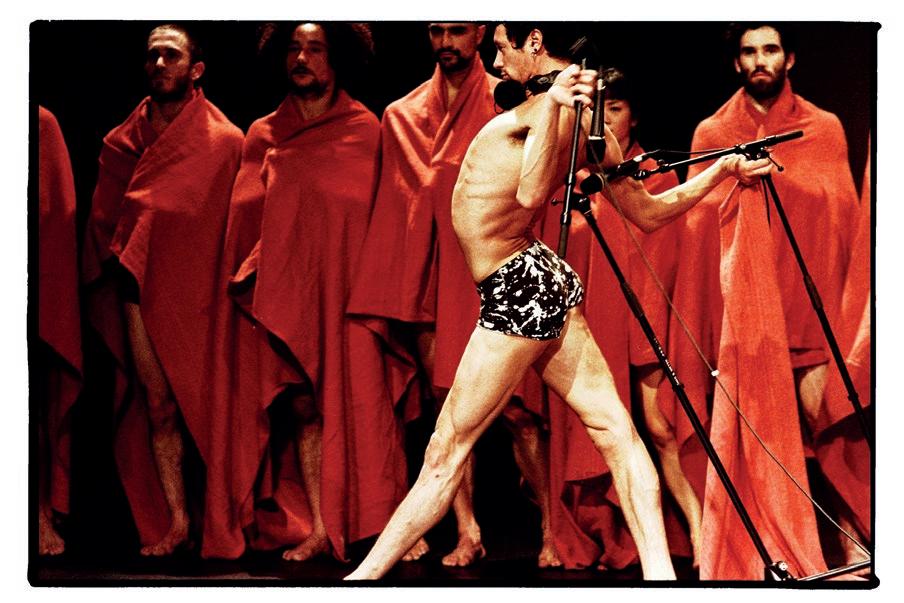
les ballets C de la B/Alain Platel, Out of Context–for Pina, 2010, photograph. © Chris Van der Burght
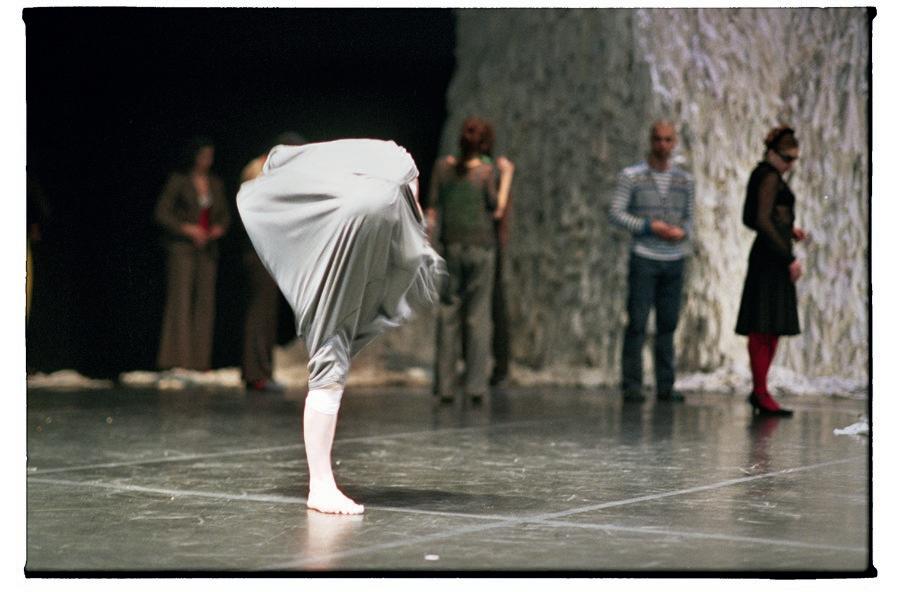
century. Initially, this was for diagnostic reasons. Doctors like Cesare Lombroso (1835–1909) saw a link between creativity and mental illness. He compiled the work of prisoners and psychiatric patients, concluding that artistic talent was a form of hereditary insanity. It was a regression to an earlier stage in evolution, the reappearance of the sickly characteristics of distant ancestors. This fitted in with the theory of degeneration, which was highly influential in the late nineteenth century.
By the early twentieth century, psychiatrists were interested in the aesthetic qualities of the work and publications appeared for the first time that were accessible to a wider audience. Marcel Réja (1873–1957), the pseudonym of French doctor Paul Meunier, considered the work of psychiatric patients through the eyes of an art critic in L’art chez les fous in 1907. He is thought to have worked with Dr. Auguste Marie (1865–1934), who established the Musée de la folie in the psychiatric hospital in Villejuif in 1905 with work from patients. He pointed to Bethlem Hospital as his inspiration, where he had seen a similar exhibition in 1900.
The book that gave the art of psychiatric patients a podium for the first time was Bildnerei der Geisteskranken (Artistry of the Mentally Ill) (1922) by Hans Prinzhorn (1886–1933). The German psychiatrist and art critic was recruited by the psychiatric hospital in Heidelberg in 1919 to expand the existing small collection of works by psychiatric patients and to write about them. He wrote to the directors of hospitals in various countries in his search for original work that had already been created, and he gathered a collection of almost 5,000 pieces from more than 400 patients. He also advised the hospital boards to provide patients who wanted to draw with the necessary materials. His letter explained that the intention was to allow some of the work to be exhibited in a museum. In contrast to Jean Dubuffet, Prinzhorn was not anticultural and did not want the work to be excluded from the art world. He even tried to have it exhibited in fine art galleries. In his introduction, Prinzhorn wrote that he did not want to use the word ‘art’, because a value judgement is intrinsic to it: the distinction between ‘art’ and ‘nonart’. Instead of drawing new boundaries, he wanted to demolish walls. Prinzhorn chose Bildnerei as an alternative for the term, and wrote that, above all, the work showed similarities with contemporary art, an art that, ‘in its search for intuition and inspiration, consciously strives for psychiatric attitudes that can be found in schizophrenia’.
This is why many expressionistic and surrealistic painters were very interested in the book. They saw an authenticity and power of imagination in the work that wasn’t reflected in the established art world. Similarly, Paul Klee saw a ‘direct spiritual vision’ in the work of psychiatric patients and argued that art does not reproduce the visible; rather, it makes visible. In his view, the child and the savage could also do this. Max Ernst attempted to enter this ‘no man’s land’ with specific techniques such as frottage and collage.
The artist who would play a key role in making the art of psychiatric patients more widely known, however, was Jean Dubuffet (1901–1985). In July 1945 he travelled to various psychiatric hospitals in Switzerland, where he saw the work of Adolf Wölfli. After his return, he wrote a letter to the painter René Auberjonois in which he used the term art brut for the first time. This was the beginning of a collection that was housed in Lausanne as the Collection de l’Art Brut in 1976, and which has enjoyed world fame ever since. Art brut was strictly defined, and the biography of the artist and his or her unfamiliarity with the art world played an important role. According to American art critic Hal Foster, transgression was central to Dubuffet, and it was expressed in, among other things, instinct, passion and madness. He was looking for another, authentic, primitive art on which he could take a clear position: art brut against art culturel. By maintaining such a sharp distinction, however, these works were confined to a restrictive term and anxiously excluded from the established art world.
Although outsider art is a controversial term, it still inspires artists. The Quay Brothers’ stopmotion animation In Absentia was inspired by the writings and drawings of Emma Hauck, an artist included in the Prinzhorn Collection. Hauck was admitted to the psychiatric hospital in Heidelberg in 1909 at the age of 31 and wrote love letters to her husband. ‘Come, darling’ (Herzensschatzi komm) can often be read, repeated obsessively or sometimes just ‘Come’. The words fill the sheet so that it is no longer a letter but a picture.
The word outsider is also linked at several levels with photographer Roger Ballen. He made portraits of marginalised white people in the isolated rural areas of South Africa in the 1980s and 1990s. The camera was unforgiving, but their portrait made their existence a reality, albeit a confrontational one. Stagemanaging
his work became more prominent at the start of this century. By moulding reality into ‘installations’, the absurd and alienation were given free rein. Series such as Shadow Chamber (2005), Boarding House (2009) and Asylum of the Birds (2014) can be regarded as metaphors for the soul and are full of recurring elements such as animals, broken objects, organised chaos and body parts. Drawings also play an important role and seem to have an effect on the living protagonists in the photo. Ballen himself says that he was inspired by outsider art. He also recognises what his predecessors saw in the works, ‘something very basic, very primitive and psychological’. His photos must, he says, be able to transform people and let them discover places in the soul that have never been visited before.
THERAPEUTIC AID
Since the 1940s, creative therapy has been based on the idea that the imagination can have a role in healing. The idea itself dates back to the Egyptians or to the cathartic effect of Greek drama.

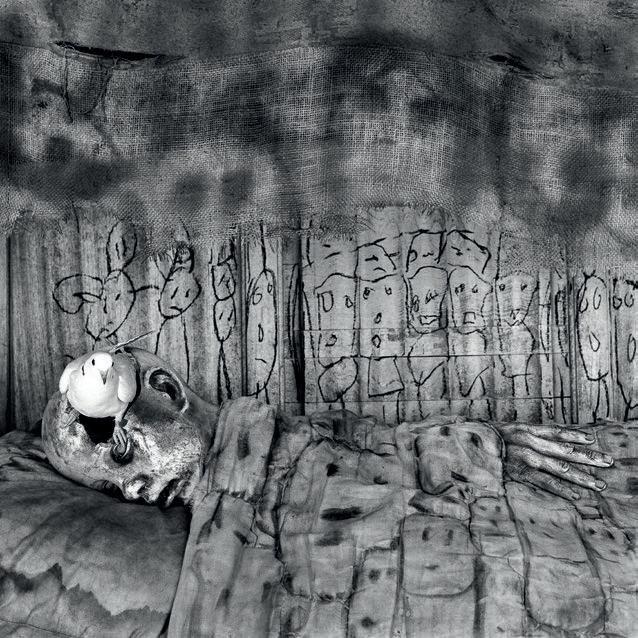

Joseph Guislain (1797–1860) also allowed his patients to paint, preferably in the open air. In his Traité sur l’aliénation et sur les hospices des aliénes in 1826, he wrote: ‘It is there that a beautiful sky, groups of trees, romantic places, picturesque views and colour nuances of whatever subject demand attention and allow him to forget the dominant idea of his insanity.’
Creative therapy was introduced in the 1940s as a new form of occupational therapy. It also had a therapeutic effect because drawing and painting were believed to make unhealthy thoughts visible. The idea was that one would then be able to understand the illness better.
In the 1960s the diagnostic function was abandoned and visual creativity took on the form of nonverbal psychotherapy. Artists started working in psychiatric hospitals with patients and set up studios, as Vincent Halflants did in the psychiatric hospitals in Tienen and Diest from 1969. The work of his ‘students’ was meant to have a stabilising effect, was a means of finding balance. He allowed them to draw and make sculptures in order to discover themselves. The Speelhoven Collection, which Halflants gathered as an archivist and curator, was donated to the Dr. Guislain Museum in 2018.
Jan Hoet (1936–2014) recognised the importance of the collection by including work in the Open Mind exhibition at the Museum of Contemporary Art in Ghent in 1989. Hoet was the son of a doctor in Geel and grew up with patients who lived with his family (a form of ‘foster care’ that is still common in the area). His introduction to the publication for the exhibition Y.E.L.L.O.W, which he curated in Geel in 2001, contained words that are evidence of the centuriesold fascination with madness: ‘For us children, our housemates were fascinating because they did not have to comply with the rules and standards of society, but created their own laws and conditions. We saw this as proof that they had more imagination and freedom than others. I see that differently now, of course; reality is much more complicated than that.’
Roger Ballen, Deathbed and Threat, from the series Asylum of the Birds,
2010–2011, photographs. Artist’s collection, Johannesburg. Dr. Guislain Museum, Ghent

Peter Cuyvers, untitled, undated, coloured pencil on paper.
Speelhoven Collection, Tienen and Diest. Dr. Guislain Museum, Ghent

Tower of Eben-Ezer, 2005, scale model. Bozar, Brussels. Dr. Guislain Museum, Ghent
MUSEUM OF OBSESSIONS
Between 1948 and 1963, Robert Garcet (1912–2001), a stonemason, worked with family and friends on a tower that was 20 metres high. The tower of EbenEzer, built in EbenEmael in the north of Liège after the Second World War, is a symbol for peace and against all forms of violence. The name refers to the place where, according to the Bible, Samuel erected a stone to commemorate the victory of the Israelites over the Philistines in 1038 BC. Garcet also undertook geological, paleontological and archaeological research, and formulated theories about the origin of humankind. His pacifist message attracted many guests and the tower can still be visited today.
Swiss curator Harald Szeemann (1933–2005) discovered Robert Garcet’s work in 1982 and became a regular visitor. He showed work by Garcet in Der Hang zur Gesamtkunstwerk (The tendency towards the total work of art) (1983), and had a model of the tower made for Visionair België (Visionary Belgium), an exhibition in 2005 marking the 175th year since the founding of Belgium. It was also Szeemann’s last exhibition. Garcet is representative of the artists who do not follow a particular style or tendency but create their own ‘individual mythologies’. According to Szeemann, the subjective, inner world of the maker contributed to a large degree to a better and deeper understanding of the work. He wanted to escape pigeonholing and fought for a Gesamtkunstwerk and a Museum of Obsessions, where art and life are entwined. He brought art brut and recognised artists together, and combined their work with documentary material and artefacts, such as dolls and votive offerings, but also folk art, for example. In 1963 he exhibited the by then forgotten Prinzhorn Collection in the Kunsthalle Bern under the title Bildnerei der Geisteskranken — Art Brut — Insania Pingens. The title of the book by Hans Prinzhorn also became the name of one of the sections in Documenta 5, where Adolf Wölfli’s cell was reconstructed, and works and artefacts from the psychiatric hospital in Waldau were exhibited. He also endeavoured to show the work in the way it would have been seen in the hospital.
For Harald Szeemann, limits were there to be transcended: art brut was just as valid as any other art. The most important thing for him was the intensity, the passion with which work was made and how the art is anchored in the life of the artist. Obsession was the same as positive energy and freedom of expression.
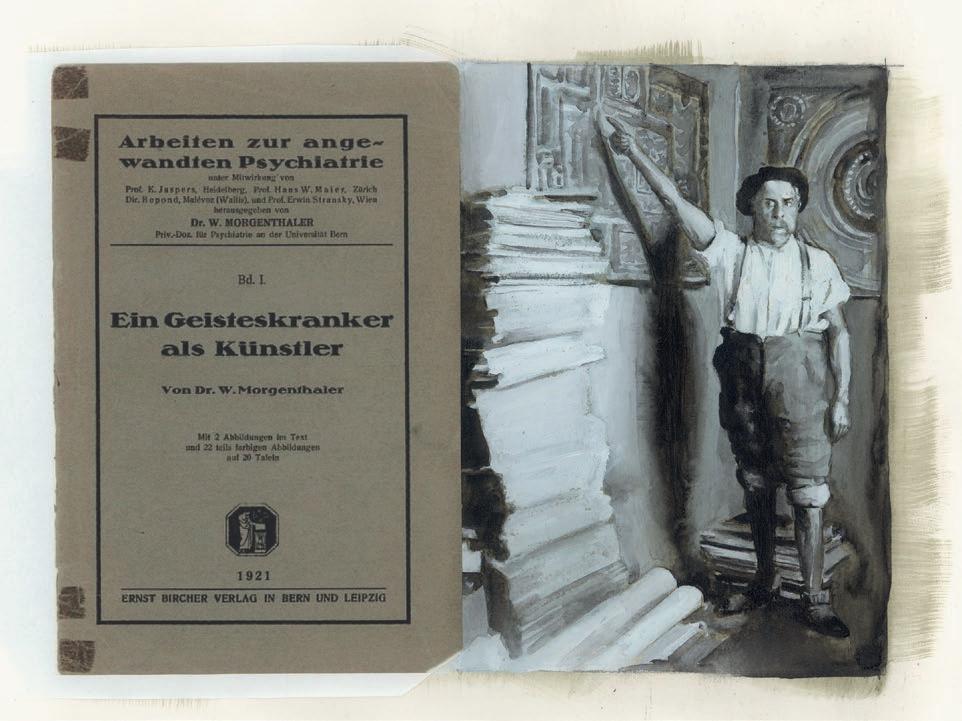
Jan De Maesschalck, Untitled, 2007, acrylic and acrylic medium on paper.
Dr. Guislain Museum, Ghent. Courtesy of Zeno X Gallery, Antwerp. © 2019 – Jan De Maesschalck / SOFAM – Belgium
In 1921 the psychiatrist Walter Morgenthaler (1882–1965) wrote a monograph on the work of one of his patients, Adolf Wölfli (1864–1930), Ein Geisteskranker als Künstler (A mental patient as artist). Wölfli began to draw in the psychiatric hospital in Waldau when he was 35. The result was a Gesamtkunstwerk of about 25,000 pages, consisting of drawings, text and musical compositions. In Untitled, Jan De Maesschalck (b. 1958) confronts the cover of Morgenthaler’s book with an iconic photo of Wölfli in his cell. He also looks to existing images for inspiration in other pieces. He selects, fragments and interprets them, creating new, often melancholic tableaus.
Jan Hoet shared this view and concluded his introduction in the publication Y.E.L.L.O.W with the following words: ‘Although Y.E.L.L.O.W has nothing to do with the Museum of Obsessions, it is a conviction that I share with Szeemann. Y.E.L.L.O.W should demonstrate, albeit indirectly, that commitment and passion are the motor of artistic creativity. I also have the feeling that we can only gain an insight into “the other” if we direct our attention to the way he expresses himself, to the form of expression he chooses. And this applies just as much for artists and psychiatric patients as it does for people in general.’
The other has been regarded, examined and categorised with fascination throughout the centuries. The other was found fascinating because different from us, from our reality. However, we must not forget that the other is also a part of this reality and there is therefore no difference. Just as plants can be diverse, so can people, and therefore imagination can also be diverse. Will all inequality end when outsider art is no longer called such but fully accepted by the art world? Or should there be an openness in respect of different forms of expression, which all arise out of the same obsessions? Thomas Röske, director of the Prinzhorn Collection, concluded his essay Outsider Art — The Past and Present of an Idea (2019) with the following thought: ‘For Outsider Art to be truly integrated (and hence included) in the art world, we will have to broaden our understanding of art to such an extent that we no longer expect the individuals behind artworks to have the same apprehension of reality as we have. This in turn means being open to a wealth of alternative messages, no matter how weird and bizarre they appear to be.’
BIBLIOGRAPHY
Faupin, Savine & Boulanger, Christophe (ed.). Danser brut. Villeneuve d’Ascq:
LaM, 2018 Fol, Carine. From Art Brut to Art without Boundaries. A Century of Fascination through the Eyes of Hans Prinzhorn, Jean Dubuffet, Harald Szeemann.
Milan: Skira Editore, 2015 Foster, Hal. ‘Blinded Insights: On the Modernist Reception of the Art of the Mentally Ill’, in: Cooke, Lynne (ed.). Martin Ramirez: Reframing
Confinement. Madrid: Museo Nacional Centro de Arte Reina Sofia, 2010

Painting studio, Hospice Guislain, 1887, photograph. Dr. Guislain Museum, Ghent
Gilman, Sander L. Seeing the Insane. A Visual and Cultural History of Our Attitudes Toward the Mentally Ill. New York: John Wiley & Sons, 1982 MacGregor, John M. The Discovery of the Art of the Insane. Princeton, New Jersey:
Princeton University Press, 1989 Prinzhorn, Hans. Artistry of the Mentally Ill. Vienna: Springer-Verlag, 1972 (reprinted 1995) Quaghebeur, Rolf (ed.). Y.E.L.L.O.W. Tentoonstelling over actuele kunst en psychiatrie.
Ghent: Stedelijk Museum voor Actuele Kunst, 2001
Illustration from: Robert Burton, The Anatomy of Melancholy, 1652, London.
Dr. Guislain Museum, Ghent
In 1621 Robert Burton (1577–1640) published his masterwork The Anatomy of Melancholy, in which he brought together two thousand years of medical knowledge from ancient Greece to the seventeenth century. The Anatomy of Melancholy was a standard work about the causes of, and remedies and treatments for, melancholy. Melancholy was considered an imbalance of the humours with an excess of black bile. The symptoms were despondency, depression and inactivity. Burton suffered from melancholy himself and hoped that writing would help him.
From the third edition in 1628 onwards, a title plate was included in which the various forms of melancholy were depicted in characteristic ways. A poem explains the plate. The philosopher Democritus can be seen in the middle at the top, in a typically meditative pose leaning his head against his hand. He is sitting in a garden with the sign of Saturn in the sky, a planet that was linked to the melancholic temperament. Two causes of melancholy can be seen left and right of the scene: jealousy and loneliness. Inamorato, the melancholy of love, is depicted under ‘jealousy’. Hypochondria, the worst form of melancholy, is depicted under ‘loneliness’. Below left is a kneeling monk who represents religious melancholy; to the right, a raving madman. At the bottom, borage and hellebores are depicted, a herb and a plant that were used as medicine. Underneath the text in the middle we see the writer himself with the book in his hand. He is depicted with two symbols that refer to scientific research: the armillary sphere and the ferula, which in turn can be connected with the stick and inflated pig’s bladder of the madman. It symbolises the journey of discovery that Burton undertook with his book in the universe of melancholy.

Variétés de la grande attaque hystérique, from: Paul Richer, Études cliniques sur la grande hystérie ou hystéroépilepsie, 1885, Paris.
Dr. Guislain Museum, Ghent


Anonymous, Fever-induced visions, 1821, ink and watercolour on paper.
Nauta Collection, Rotterdam

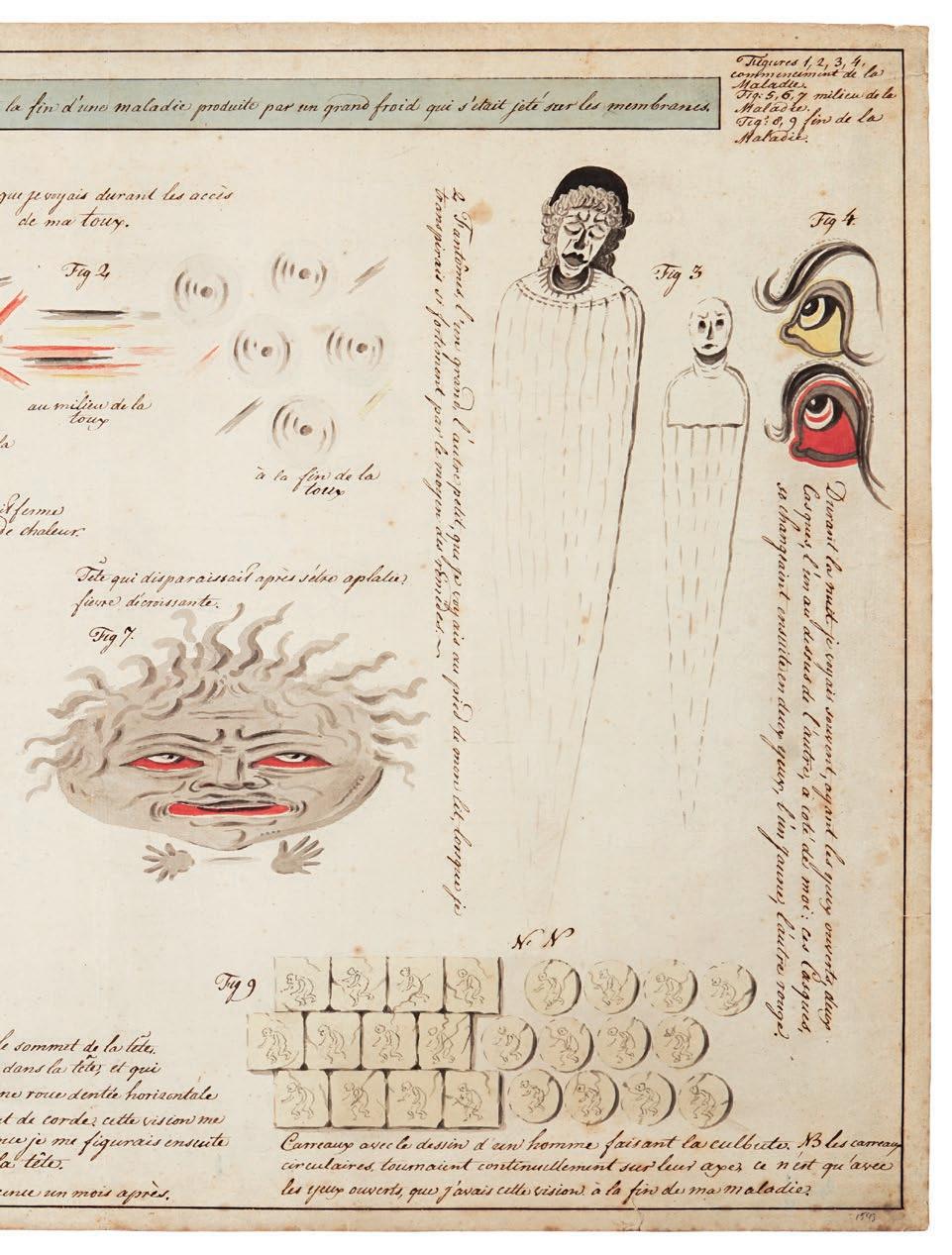
Oswald Tschirtner, Eine Sardinenbüchse (A sardine can), 1971, ink
and gouache on paper. De Stadshof Collection Foundation. Dr. Guislain Museum, Ghent
Psychiatrist Leo Navratil (1921–2006) started using drawing tests for his patients in the Maria Gugging psychiatric hospital near Vienna in 1954. He gave them the instruction to draw a human figure in pencil on a piece of paper the size of a postcard. He quickly realised the quality of many of the works and started a form of creative therapy. A number of patients drew his particular attention, including Johann Hauser, August Walla and Oswald Tschirtner. In the late 1960s Jean Dubuffet confirmed that the work of these artists was, indeed, art brut. In 1981 Navratil set up the Centre for Art and Psychotherapy in a pavilion that had become free and where patients could live and work. Psychiatrist and artist Johann Feilacher succeeded Navratil in 1986 and changed the name of the centre to ‘Haus der Künstler’, the House of the Artists. From that moment on, the focus was on the artist and his or her work, entirely separate from their status as patients.
The work of Oswald Tschirtner (1920–2007), who began to draw in the 1960s, is conspicuous because of its simplicity. His figures consist of a head and two arms and legs. They look mostly left and are stripped of any clothes and any characteristic that could distinguish them from each other. Even the haircut is the same. Tschirtner writes the title of his work at the top, and it is often as minimalist as his style. Because of his faith, he often drew religious scenes, such as Judith with the head of Holofernes. The figure of a crucified Christ is also a recurrent theme. Besides people, he drew Ein Buch, Eine Banane, Ein Hut, Eine Windmühle and even Ein Punkt (a book, a banana, a hat, a windmill, a dot). Occasionally he fills his contours in with colour, always pure colours, applied with the same sensitivity. Although his subjects have been reduced to their essence, we see what is undeniably his essence, suddenly allowing us to see things in a different way.


Marie Lieb, untitled (photograph of the floor of the room), 1894, inv. no. 1771/1.
© Prinzhorn Collection, University Hospital Heidelberg
Two photos were taken in the psychiatric hospital in Heidelberg in 1894. The name Marie Lieb was stated on both of them. One of the photos was published in Atlas und Grundriss der Psychiatrie (1902) by Wilhelm Weygandt (1870–1939), the assistant of Emil Kraepelin (1856–1926). The caption reads: ‘Patterns of figures, made of pieces of bedclothes, spread out on the floor of her room by a manic woman.’ Women often tore their hospital clothes and sheets into pieces in order to make new clothes out of them and other things. Marie Lieb (1844–unknown) may have regarded this piece as a strategy in order to reverse the balance of power. Katharina Detzel, untitled (photograph of Katharina Detzel with handmade male rag doll), 1914, inv. no. 2713a.
© Prinzhorn Collection, University Hospital Heidelberg
Katharina Detzel (1872–unknown) resisted the hierarchical structure in the psychiatric hospital of Klingenmünster in which patients were oppressed and subjected to inhuman punishments. She used her imagination to express her need for freedom. She made keys from wood and a human figure with wings, for example. In addition to the many small dolls she made from dough, she also made this life-size male rag doll from sacks and straw.
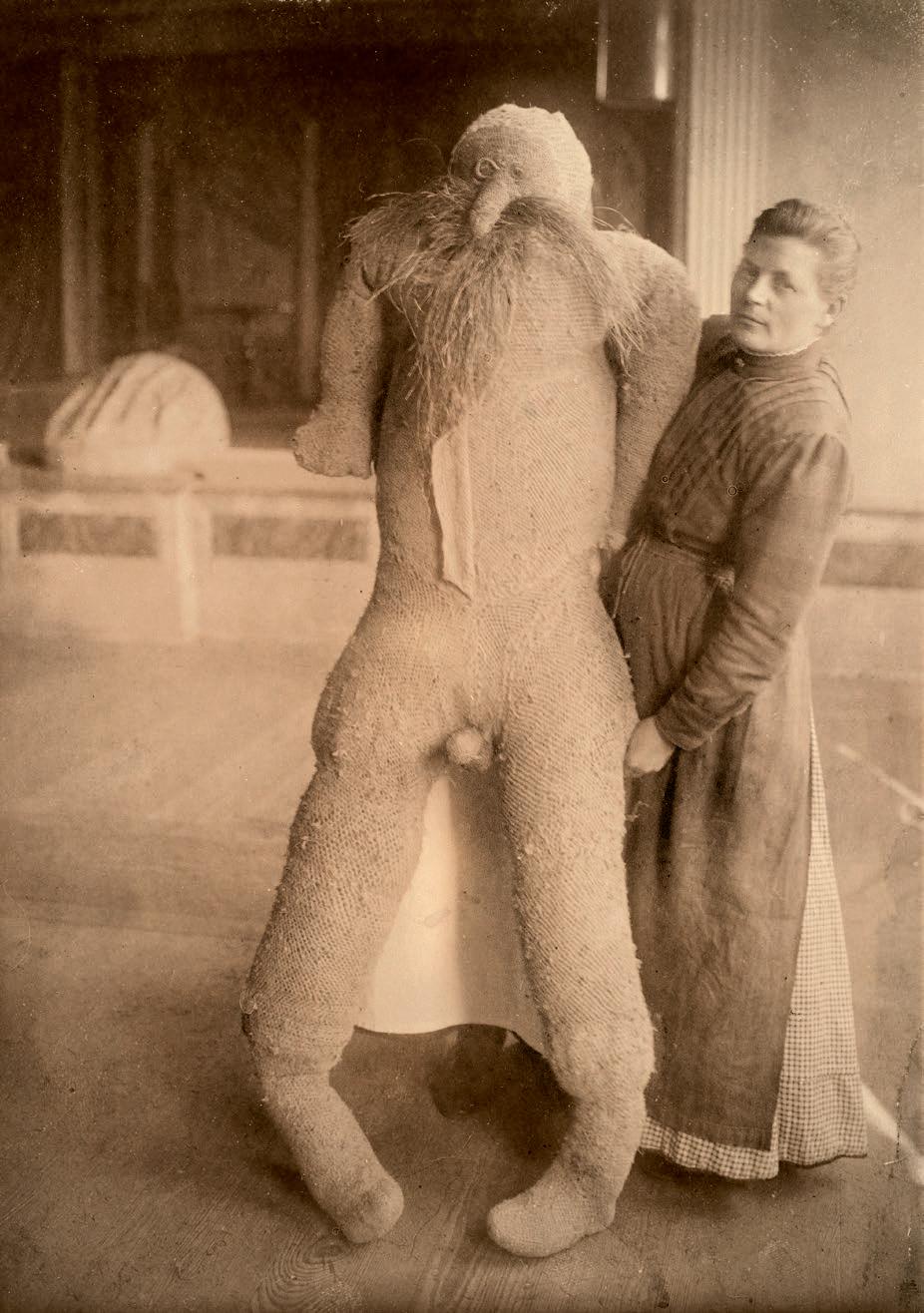

Karin Borghouts, from the series Museum Dr. Guislain, 2019, photograph.
Dr. Guislain Museum, Ghent. © 2019 – Karin Borghouts / SOFAM – Belgium
Félicien Rops, La tentation de Saint Antoine (The Temptation of St Anthony), 1887,
etching by François Courboin, inv. G E0839. Musée Félicien Rops, Province de Namur. © Musée Félicien Rops
Sigmund Freud (1856–1939) wrote in Der Wahn und die Träume in W. Jensens ‘Gradiva’ (1907) that artists could be interesting allies whose testimony deserved a lot of attention because they have insight into matters ‘in heaven and earth’. According to Freud, La tentation de Saint Antoine by Félicien Rops (1833–1898) illustrated his theory about repression. What distinguishes the work from other depictions of St Anthony is that the sin—the woman—appears on the cross in the same pose as Christ, while ‘other painters, who did not possess such penetrating psychological insight’, always depicted the sin in a provocative pose next to the Saviour. According to Freud, Rops would have been aware of the fact that that which is repressed (sexuality) will always resurface in that which does the repressing (religion).


Klaas Koopmans, ‘Gerritsen’ met curieuze hoofdtooi (‘Gerritsen’ with strange headdress), 1959, pencil and watercolour on paper.
Stichting Klaas Koopmans. Dr. Guislain Museum, Ghent
Like other members of the Frisian artists’ collective Yn ’e Line, Klaas Koopmans (1920–2005) painted mainly landscapes and people around him in an expressionist style. His institutional drawings are also conspicuous. He made them during his admission to several hospitals. He did it secretly, because drawing and painting were forbidden during three of his four admissions as they were not considered therapeutic. He depicted his fellow patients with found materials. The portraits inspired him. They also helped him to deal with being in the institutions.
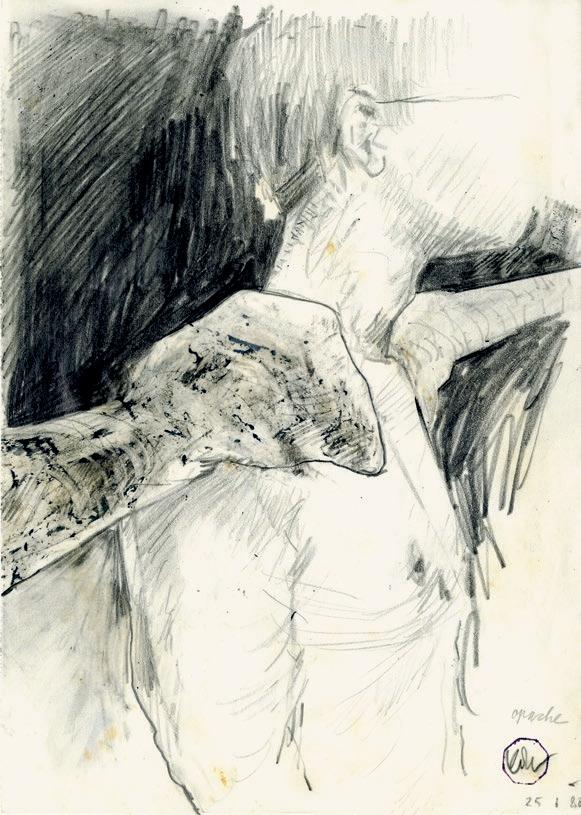

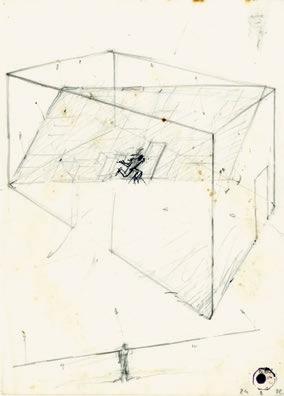
Eric De Volder, untitled, undated and 1982, pencil on paper.
Archives of Eric De Volder – Tania Desmet. Dr. Guislain Museum, Ghent. © SABAM Belgium 2019
Theatre director Eric De Volder (1946–2010) recorded his dreams in sketches and always dated and described them. The subconscious played an important role in his work. De Volder used ‘the dance of the shadow of the subconscious’ during his creative process and described his dreams as follows: ‘Just as the sun throws a shadow in front of me and that shadow moves when I move, I imagine that my subconscious also throws a shadow.’ De Volder’s view is inspired by a quotation from Carl Gustav Jung, who defined the subconscious as ‘everything in the future that prepares itself in me and of which I will only become conscious in the future’.
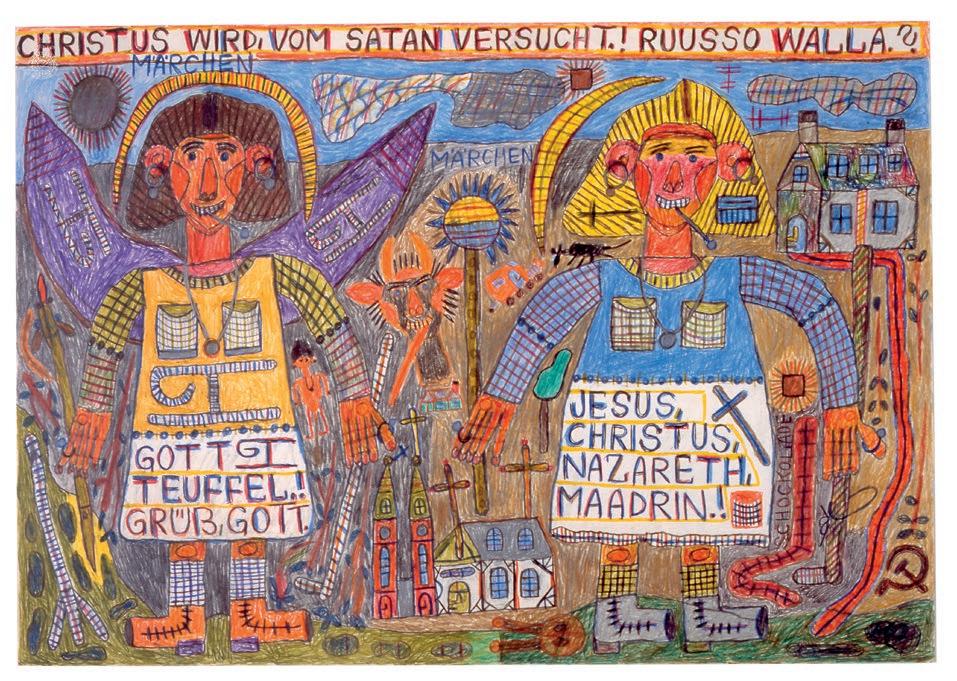
August Walla, Christus wird vom Satan versucht (Christ is tempted by Satan),
undated, crayon on paper. De Stadshof Collection Foundation. Dr. Guislain Museum, Ghent
August Walla’s (1936–2001) drawings are larded with symbols and words. The hammer and sickle and the swastika are motifs that refer to the occupation of Vienna by the Soviet and Nazi regimes during his childhood. Walla’s work invokes its own mythology full of angels, gods and demons. He added self-made words to his drawings as well. He mixed German with other languages—sometimes understandable, sometimes not. These words occupy a prominent place in his work. Walla expresses his thoughts with an arsenal of materials, on paper and walls in clay, chalk, paint or felt-tip pen, in a variety of colours and forms, sometimes monumental, sometimes so small that it can fit in one’s hand.
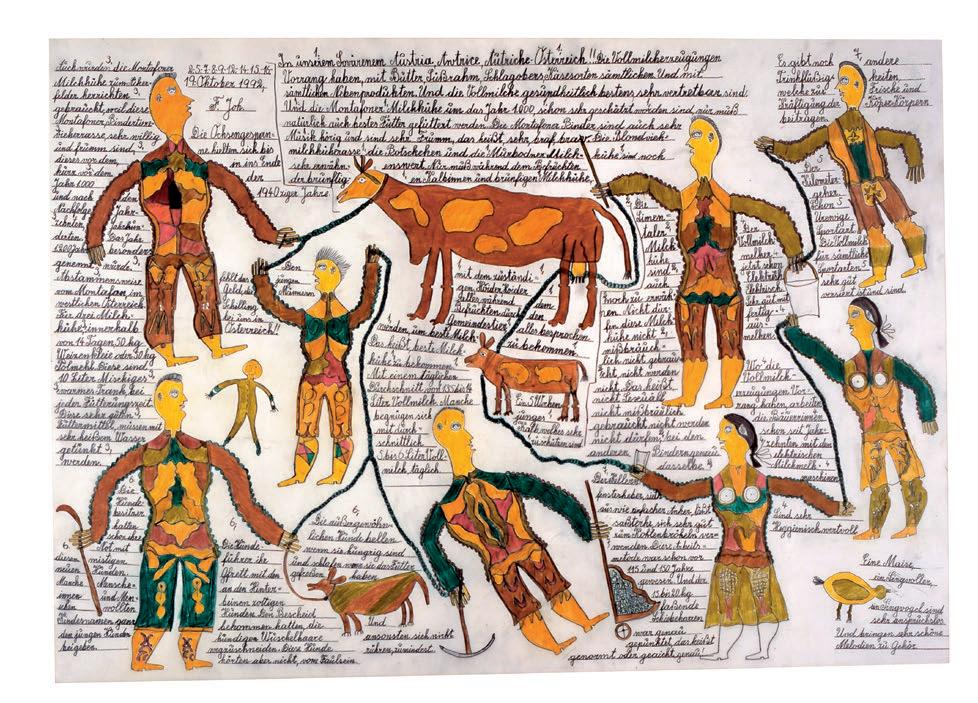
Johann Fischer, Die Vollmicherzeugungen (The whole-milk generations), 1992, pencil and colour pencil on paper.
De Stadshof Collection Foundation. Dr. Guislain Museum, Ghent
Johann Fischer (1919–2008) began his artistic career when he was admitted to the psychiatric institution in Gugging, near Vienna. He made some drawings in pencil inspired by his daily life: farm scenes, plants, animals, etc. His work evolved: not only did he use more and more colour, but the compositions grew more complex. The narrative became more important. The text that is written around and between the figures refers to what can be seen, but also reflects Fischer’s view of religion and society.
Zoe Beloff, Charming Augustine,
2005, film. Dr. Guislain Museum, Ghent
Past and present meet in the work of artist Zoe Beloff, who was born in Scotland in 1958 and lives in New York. She mixes historical fact with fiction and uses new techniques to honour old ones. To do so, Beloff makes use of diverse media, such as film, performance, installation, drawing and text. She pays attention to the fringes of society, which she defines as ‘women, the working class, dreamers and utopians’. She considers herself ‘a medium between the living and the dead, between what is real and imaginary’. The human psyche is often a source of inspiration. Everything comes together in the 3D film Charming Augustine.
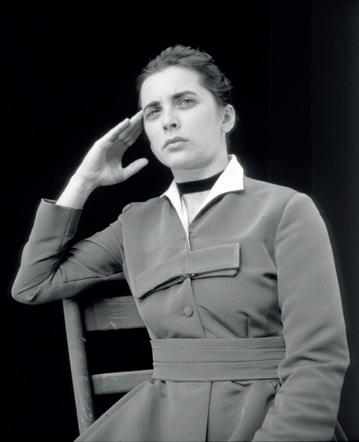
Zoe Beloff was inspired by the photos of Augustine, a psychiatric patient who suffered from hysteria. These photos were taken at the Hôpital de la Salpêtrière in Paris and published in the Iconographie photographique de la Salpêtrière, which appeared from 1877 to 1880. The artists of her time were inspired by the theatricality she exhibited during the various phases of a hysterical attack. She became a star. Charming Augustine tells the story of this young woman who was admitted in 1875 at the age of 15. There was a history of abuse. Her history, which ended with her escape from the asylum, is entwined in Charming Augustine with the birth of the medium of film. Photographers at the Hôpital de la Salpêtrière experimented with chronophotography by quickly taking successive pictures in order to capture movement. It was hoped that this would allow doctors to penetrate more deeply into the mind of the patient. By employing stereoscopy, the predecessor of 3D, in this work, Beloff investigates what film may have looked like, had it been invented in the 1880s. Charming Augustine intriguingly combines both histories.
Paul Regnard, Début d’une attaque (Onset of a hysterical attack), photograph of Augustine Gleizes, from: Iconographie photographique de la Salpêtrière,
volume 2, 1877–1878, Paris. Dr. Guislain Museum, Ghent
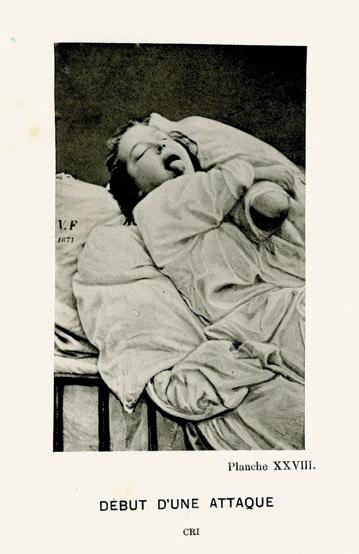
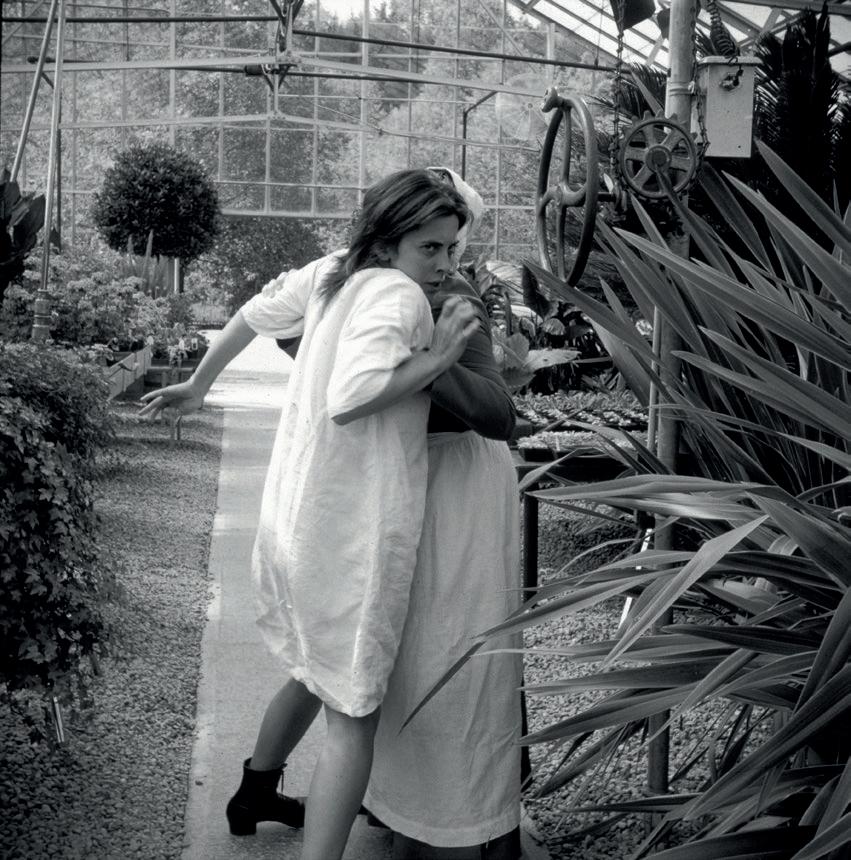


Abb. 10a und b. Schizophrenie (Ill. 10a and b. Schizophrenia), from: Oswald Bumke, Lehrbuch der Geisteskranken, 1929, Munich.
Dr. Guislain Museum, Ghent
‘Because of inappropriate isolation in a cell, the patient has torn a sheet and made a fantastic piece of clothing from the strips.’
Madge Gill, untitled, undated, Indian ink on paper.
De Stadshof Collection Foundation.
Dr. Guislain Museum, Ghent
Guided by the spirit Myrninerest, Madge Gill (1882–1962) drew her mysterious female figures all night long. It always seems to be the same woman, but it is anyone’s guess who she is: herself, her mother, aunt or unborn daughter. Gill’s interest and belief in spiritualism was encouraged by her aunt and was the mainspring of her artistic creation. She regarded Myrninerest as her spiritual guide and inspiration, but the spirit was also a burden because of its compulsiveness. Most of Gill’s work consisted of black-andwhite drawings, from the size of a postcard up to canvases several metres high. She produced an enormous oeuvre, which was only made public after her death.

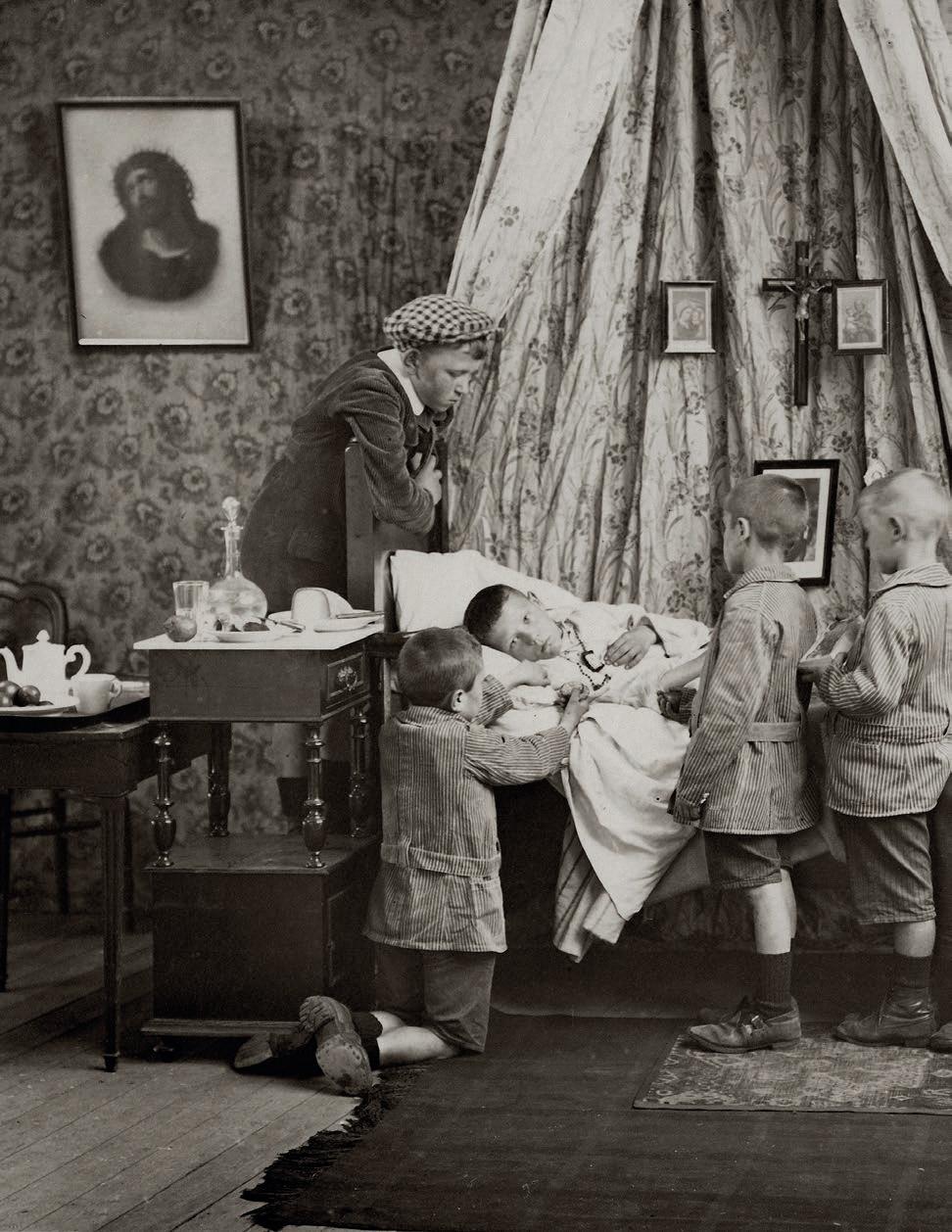

Ebergiste De Deyne, untitled, first half of the twentieth century, photographs.
Dr. Guislain Museum, Ghent
The generic scenes by brother, educationalist and photographer Ebergiste De Deyne (1887–1943) demonstrate how pupils from the Sint-Jozefinstituut in Ghent were supposed to behave in certain situations. The didactic photos depicted everyday activities like polishing shoes, grinding coffee and reading the newspaper, but also professions and the husband-wife relationship in the family context. They are extremely posed and arranged in the tiniest detail.


Jasper Rigole, In Search of a Place on the Art Market, I Decided to Become a Painter. Part 1: Early Drawings 1983–1985, 2008, eight drawings on paper, video.
Artist’s collection, Ghent
According to psychoanalyst Melanie Klein, free association cannot be used with children under a certain age and so a play situation was used. The child could then establish contact with the therapist by using objects and drawing materials. Drawing became an important means of communication. In 2008 Jasper Rigole (b. 1980) decided to submit a collection of his own childhood drawings to a psychologist specialising in the subject. He did not tell her that they were his own drawings. The psychologist came to her conclusions, including that the drawings were made by a boy and that the often sombre and atypical colours could indicate a mild depression. Another possibility was that he was colour-blind.
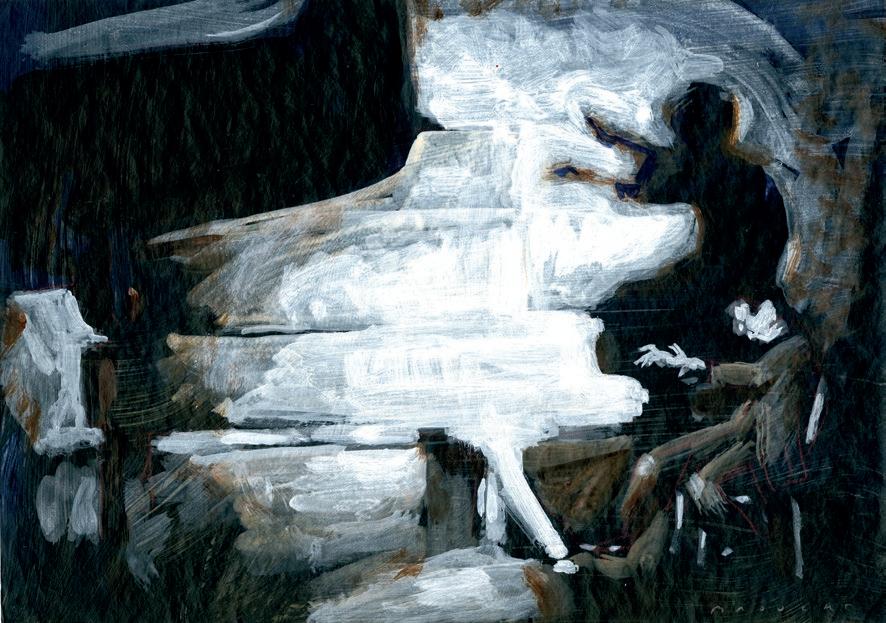
Koen Broucke, Liszt-Broucke, Our Travelling Circus Life II, 2004,
acrylic on paper. Dr. Guislain Museum, Ghent
The psychiatrist Hahneman is a fictional character who has compiled work by equally fictional patient-artists. He is convinced that contemporary art is sick and that artists are seriously disturbed. The work of Koen Broucke (b. 1965) treads a fine line between fact and fiction in which his characters are actually lighthearted self-portraits. Each of his characters has his or her own biography, idiosyncrasies and longings. It gives Broucke the opportunity to explore art in every possible direction.
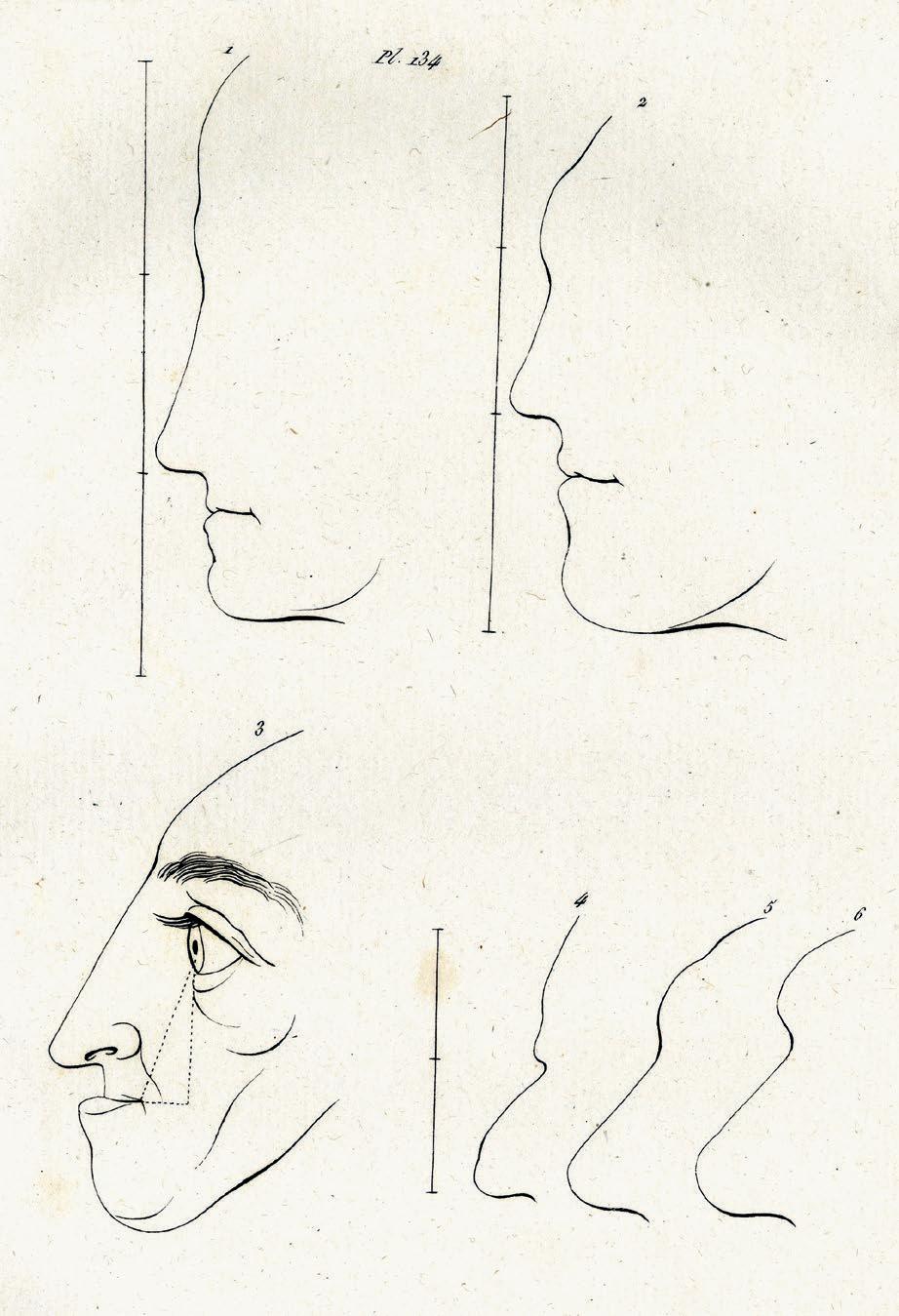
CLASSI FICATION
Illustration from: Johann Caspar Lavater, L’art de connaître les hommes par la physionomie (The art of knowing men by their physiognomy),
volume 3, 1806, Paris. Dr. Guislain Museum, Ghent



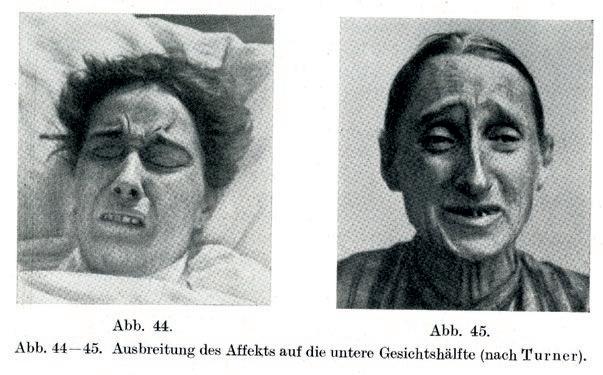



Illustrations from: Theodor Kirchhoff, Der Gesichtsausdruck und seine Bahnen beim Gesunden und Kranken, besonders beim Geisteskranken (Facial expressions and their traces in the healthy and diseased, especially in the mentally ill), 1922, Berlin. Dr. Guislain Museum, Ghent







